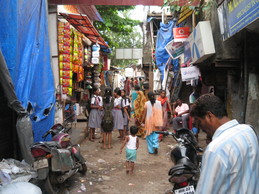I began work at Swadhaar FinServe during the very hectic collections week, the designated dates of each month when the loan installments of all 80,000 active clients are due. While some clients choose to pay their installment by visiting a local Swadhaar branch office, many opt to have their loan officer (LO) make a scheduled visit to their slum community. Each of Swadhaar's roughly 250 loan officers are responsible for a number of slum neighborhoods, or zones, scattered throughout Mumbai and the LOs spend this week hustling hurriedly through their zones as they collect loan repayments from their clients.
Nilesh is a Swadhaar loan officer who works primarily with the group loan product, a loan that is specifically designed for groups of three to five working women whose income level falls under the international poverty line of $2 a day. Early in my first week at Swadhaar, I accompanied Nilesh on a typical day as he visited his zones located throughout the northern Mumbai district of Santacruz. He carries with him a roster which lists all the client loans that are due on that particular day. This list includes specific information regarding each group leader, the woman that has been designated as the contact person and who is ultimately responsible for collecting money on behalf of the group and meeting repayment deadlines.
We start the day by knocking on the house of a woman who runs a jewelry making business with several other women in her community. As we are invited into her home, we see the women crowded together on the floor, busily beading several necklaces and bracelets while children of various ages play around them. This group has used their loan to purchase new beads and jewels and they are excited to show me the new products they have created.
A few houses down, we visit a woman who has used her loan to purchase additional textiles for her clothing business, in which she sews saris for women in her community. She is on her second Swadhaar loan, or cycle, and says she has plans to renew for a third in order to continue to grow her business.
The slum communities are densely packed, with winding paths that have no street names, let alone house numbers, and so although Nilesh has spent time in these neighborhoods, he must often rely on the local residents to be pointed in the direction of the next client. We find ourselves lost several times throughout the day, having taken a left when we should have taken a right or walking past a client's home because there were no identifying markers. With little space to spare in the slum communities, homes are often stacked upon one another and in order to reach homes on the second level, we must climb an external metal ladder.
The collection due date is written into the loan contract that the client signs and is given a copy of to keep for their records. Nilesh says that he usually calls a few days beforehand to remind his clients that he will be stopping by. I notice that most women are expecting him and it is clear that he has developed a friendly relationship with many as they invite him into their homes and offer him water or tea while he fills out the necessary paperwork.
The homes in these communities usually consist of a single large room, with one corner designated for the kitchen and cooking area and another corner for the washroom. In order to conserve floor space, shelves cover the walls and are filled with dishware, pots and pans, clothes, bedding, and usually a television, that is turned on more often than not. Without many options to choose from, each woman seems to keep her money in a unique hiding place within her home. One woman opened a large jar of grain and fished out a small wallet while another lifted a photo away from the wall and reached behind it for her stack of rupees.
After nearly fifty home visits, Nilesh had made it through his roster and we returned to the Santa Cruz branch office. While most clients were home when we came by, there were a handful of women that were nowhere to be found. Nilesh places these names on a list that he will return to after the remaining scheduled collections are completed.
Although collections week is incredibly hectic and certainly exhausting, Nilesh says that he enjoys seeing his clients and learning about how they are using the loan. He asks me if I would like to accompany him again next month. He then quickly mentions that navigating the streets of the slums gets easier every time.
For more information, please visit: accionambassadors.wordpress.com
